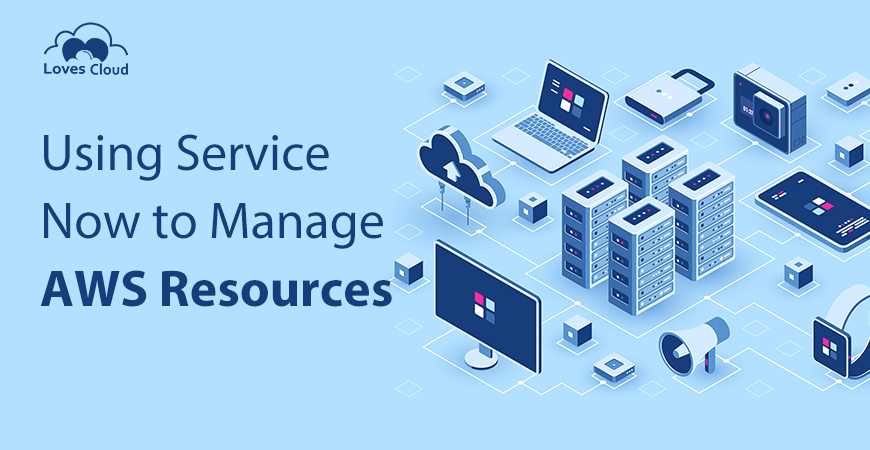
Using Service Now to Manage AWS Resources
IT service management is one of the important aspects that any technology-driven organization today should prioritize. With time as the company scales its business, the complexities grow with countless servers, applications, user requests, and bugs making their way in the organizational structure. To keep things streamlined and ensure success they must bank on a well managed IT operation. This is where ITSM tools like Service Now comes to their aid. From generating automated reports to automating (or semi-automating) bug fixes, it manages a wide range of activities thereby increasing productivity manifold.
Businesses can use Service Now to manage and monitor their existing pipeline making their digital transformation journey smoother. What’s more, Service Now can easily be integrated with AWS. This is what Loves Cloud did recently when one of the largest account holders of our client had a requirement to integrate their ITSM tool Service Now with AWS for provisioning resources in AWS and monitoring resources in AWS through Service Now.
Determining what exactly we needed to do – the goals:
We had a detailed discussion with our client company’s IT leaders and finance team. Our goals were pretty clear. We were to:
- Integrate Service Now with AWS. Service Now was already being used by our client’s account to manage their IT operations.
- Connect AWS service catalogue with Service Now so that the administrators could manage various AWS resources in an organized manner.
- Configure Service Now in such a way that it could allow usage of AWS resources from specific AWS region(s) for launching instances and for deployments: With stringent data protection laws coming up, it becomes necessary to launch AWS instances in a region specific manner. Using specific AWS Regions for deploying AWS resources would help the company follow compliance rules.
- Create a robust Request Approval process within Service Now: What resource request should need approval, who should be the approver(s), log reports of approvals and rejections – can all be configured in Service Now.
- Configure Service Now so that it could gain the ability to display a list of running AWS resources and could offer the admin the right to suspend those tasks.
How we achieved the goals:
Loves Cloud used AWS connector for Service Now to integrate the two in a seamless fashion. Next, with the Service Now AWS service account we created a record of the company’s already existing AWS account on the Service Now instance.
After that, automated discovery of AWS resources was needed. We used Service Now Discovery Schedules for AWS Cloud for that. But before this, we had to configure the Service Now instance with the company’s AWS credentials in order for the instance to access the cloud resources of AWS. We added only those AWS regions that our client was allowed to use by the local laws as the Data Centres in Service Now. Service Now has a robust ticketing workflow. We used this to launch instances in AWS – each EC2 request would go through the same Assessment-Assign-Investigation cycle that every other requisition would go through.
The tools we used
In order to implement the solution, we used the following tools:
- AWS public cloud platform to operate Service Now.
Following AWS services were prominently used:
- AWS EC2 – As the cloud based virtual machine solution to launch instances.
- AWS Config – To automatically update CMDB whenever any Amazon resource-configuration changed.
- AWS SNS – To receive important notifications via Service Now and route them to the corresponding departments of the client company.
- AWS Cloudwatch – To leverage AWS SNS properly, we used Amazon’s monitoring service CloudWatch.
- AWS Cloud Plug-ins – We used various AWS cloud plug-ins to integrate Service Now with AWS and use the tool to manage AWS resources.
- AWS Activities- A tool to connect a running code to any task in the EC2.
- AWS discovery – To collect information about cloud resources.
- Service Now – The well-known ITSM tool.
The end result
With various configurations and changes that we did on Service Now and Amazon Web Services itself, we were able to achieve encouraging results.
- After our configurations, any AWS resource management could be done via Service Now with appropriate log reports and approval/rejection policy.
- To comply with the local laws, Service Now was configured to approve the resource request in specific AWS regions.
- With Service Now in place, every resource could be controlled by the admin – from approval/rejection to suspension, from scheduling to specifying region – all could be controlled.
- For a wholesome experience, a user could set a base AMI for the entire organisation and control it through Service Now.
- Since we integrated AWS SNS service with Service Now and configured CloudWatch in an appropriate manner, every resource request and configuration change would trigger a notification and that notification would be sent to appropriate personnel.
With the right configuration, Service Now could now be used as a great tool to manage resources and organizing the IT process in a clean and effective way.
At Loves Cloud, we are constantly leveraging the power of various open source software solutions to automate, optimize, and scale the workloads of our customers. To learn more about our services aimed at the digital transformation of your business, please visit https://www.loves.cloud/ or write to us at biz@loves.cloud.

